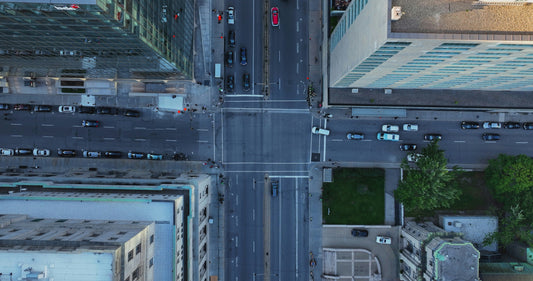The equipment you’ll need will vary depending on the situation. In a previous guide, we outlined the essential equipment required for wilderness exploration. However, other survival situations, such as natural disasters, will often require different types of preparation and gear.
At Sojourn, we offer versatile survival gear for every eventuality. In this article, I will outline the essential kit you’ll require if your home is affected by a hurricane, flood, earthquake, or wildfire.
Natural Disasters
If you live in an area at risk of natural disaster, it is recommended that you have a survival kit or a “go-bag” ready so that you can be prepared if the worst happens.
Basic survival gear for hurricanes, floods, and earthquakes
Although these three natural disasters require some differing equipment and safety procedures, you’ll need the following basic essential items for all three.
1. Water. Stored water is required for drinking, cooking, and washing. People in high-risk areas ought to have a minimum of 1 gallon, or around 4 liters, of clean water stored per person per day, for at least 3 days. Water purification tablets should also be a backup.
2. Non-perishable food. In case of power outages that affect refrigeration, it’s important to have enough non-perishable food stored to last at least 3 days. This includes canned goods, protein bars, dried fruit, etc.
4. Flashlights and batteries. If faced with a blackout, you’ll need flashlights and batteries, or rechargeable flashlights with solar or crank power.
5. First Aid Kit. A medical kit containing a minimum of bandages, antiseptic, pain relievers, and any prescription medications, is necessary.
6. Portable battery pack. A solar-powered battery pack is essential for charging phones or small devices.
7. Multi-tool. Having a multi-tool handy is useful for numerous tasks.
8. Documents and cash. Keep some cash and important documents (e.g. passports) handy and preferably in a waterproof and/or fireproof bag.
Hurricanes
Hurricanes, or tropical cyclones, affect coastal and near-coastal regions in tropical and subtropical areas. Coastal areas with flat, low-lying typography are particularly vulnerable.
These powerful storms affect all Atlantic and Gulf of Mexico coastal areas, Puerto Rico, the U.S. Virgin Islands, the Pacific Coast, Hawaii, parts of the Southwest, and U.S. territories in the Pacific.
The Caribbean islands, parts of Canada, Southeast Asia, the Pacific, and certain countries in the Indian Ocean are also affected by hurricanes.
Hurricane survival essentials
For this type of natural disaster, your survival kit needs to be focused on sustained impact. Hurricanes are often preceded by some warning, allowing for preparation time to secure your home and plan for potential evacuation or prolonged power outages.
-
Radio. A battery-powered, hand-crank, or solar-powered NOAA weather radio is required for important weather updates. This innovative solar radio can also be used as a battery pack and a torch.
-
Home protection equipment. Having a tarp, duct tape, and sandbags can help you to protect and/or repair your home.
-
Evacuation plan. You’ll need an evacuation map and set-out plan for leaving flood-prone areas if required.
Earthquakes
Earthquakes most commonly affect areas that are close to tectonic plate boundaries.
The most seismically active region is known as the Ring of Fire (Pacific Ocean) and accounts for 90% of the world’s earthquakes. This includes parts of North America, South America, Asia, and Oceania.
Other areas affected by earthquakes include the Himalayan Region, the Mediterranean-Asian Seismic Belt, the Mid-Atlantic Ridge, and the East African Rift.
Earthquake survival essentials
This type of natural disaster requires a survival kit that is focused on immediate survival. Earthquakes have few obvious warning signs, and can therefore strike instantly, leaving no time to prepare. Your kit therefore needs to focus on surviving the immediate aftermath of a quake, and preparing for structural damage and entrapment.
-
Crowbar or pry bar. Use this to help yourself or others to escape from collapsed structures.
-
Dust masks. Protect yourself from debris and dust in the air.
-
Under-bed supplies. Keep sturdy gloves for handling debris, shoes, and a flashlight by your bedside for immediate use.
-
Emergency whistle. If you become trapped you can signal to rescuers using a whistle.
Floods
Flooding can occur almost anywhere. Factors like being; close to the coast, near hilly or mountainous terrain, below sea level, in urban areas with poor drainage systems, in arid or semi-arid regions, snowmelt regions, or on river floodplains, can increase your risk of your home flooding.
Flood survival essentials
A flood survival kit needs to focus first and foremost on water safety. Floods frequently result in water contamination. This is because sewage and drainage systems overflow, contaminating floodwater with human and animal waste. Tap water can also frequently be affected by these, amongst other contaminants, chemicals, and microorganisms.
Flooding also usually results in the need for quick evacuation to higher ground.
-
Water purification. Filters, purification tablets, or portable water purifiers are necessary for providing clean, safe drinking water where bottled water isn’t available.
-
Waterproof Gear. Waterproof clothing, rubber boots, bags, dry bags for documents, and containers are essential for protecting yourself and your belongings from floodwater.
-
Life Jackets. People in areas prone to flash floods or high water levels also ought to have life jackets to hand.
-
Disinfectant spray. This is important for spraying on feet or any other skin that comes into contact with contaminated waters.
Wildfires
Wildfires occur most commonly in hot, dry climates where there is dense vegetation.
In the U.S., wildfires affect California, the Pacific Northwest, the Southwest, the Rocky Mountains, and the Southeast.
Wildfires also commonly affect parts of Canada, Australia, the Mediterranean, South America, Africa, Asia, the Middle East, and Northern Europe.
Wildfire risk is influenced by weather conditions, vegetation type, and human activity. The frequency of wildfires is currently being exacerbated by climate change, making them more of a common occurrence.
Wildfire survival essentials
While there are some overlaps in respect to survival gear with hurricanes, earthquakes, and floods, fires generally require different preparation. There are some things that you can do to prepare and protect your home from a wildfire, however, your survival plan needs to be based primarily on quick evacuation.
The basic essentials remain the same as the other natural disasters, but the fast-moving, high-heat, and smoky conditions will require different fire-specific protective wear and kit.
-
Evacuation map. Have a map with at least two evacuation routes and an evacuation plan ready if you live in a wildfire-prone area.
-
Pre-packed go-bag. Each family member should have a lightweight fire-resistant bag packed and ready for evacuation, in addition to the survival basics. This should contain each individual’s essentials, plus any small items that they wish to save should your home catch fire post-evacuation.
-
Protective face masks. You’ll require N95 masks or FFP2 NR face masks to protect yourself and your family from dust and smoke inhalation.
-
Goggles. To protect eyes from ash and smoke.
-
Fire-resistant gloves. For handling hot objects safely.
-
Fire-resistant clothing. Clothing made from Aramid fibers (e.g. Nomex), Kevlar, and Modacrylic are flame-resistant. Tight-knit fiber clothing made from materials like nylon, polyester, and acrylic also burns less easily than loose-knit clothing made of linen, cotton, or viscose. Thinner clothing also burns more easily.
-
Heat-resistant clothing. Covering the body as much as possible in thicker clothing is important in a wildfire scenario. Sturdy boots are also important.
-
Wool or flame-resistant blanket. This adds another layer of protection from flames if trapped.
-
Emergency foil blanket. This is lightweight and heat-reflective.
-
Fire-extinguisher. Keep a small portable fire extinguisher with you.
-
Radio. A battery or hand-crank radio is important for receiving updates. A solar-powered radio will likely not be appropriate, in case smoke obscures the sun’s rays.
-
Whistle. A whistle to signal for help can be useful, especially when vision is obscured by smoke.
-
Lightweight tent or tarp. In case you need emergency shelter after evacuating your home.
You can also purchase pre-made wildfire kits such as:
• Redfora Complete Earthquake Bag. Contains many wildfire essentials.
• Rescue Guard Survival Kit. Includes a broad range of supplies.
• Survivor Filter Fire Safety Kit. Focused on air filtration and protection.




